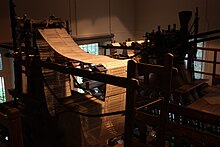User:Unicodepepper/tape draft
A brief history of tape[edit]
[estimated] table of contents:
- paper tape
- linked punched cards
- teletypes
- use in computers
- magnetic tape
- audio tape
- data tape (often repurposed audio tapes)
- dedicated video tapes
- modern data tape
https://en.wikipedia.org/wiki/Tape_library
https://en.wikipedia.org/wiki/Magnetic_tape
https://en.wikipedia.org/wiki/Tape_drive
https://en.wikipedia.org/wiki/Punched_tape
https://en.wikipedia.org/wiki/Magnetophon
https://en.wikipedia.org/wiki/Reel-to-reel_audio_tape_recording
https://en.wikipedia.org/wiki/Videotape
https://en.wikipedia.org/wiki/Helical_scan
https://en.wikipedia.org/wiki/IBM_7_track
https://en.wikipedia.org/wiki/9_track_tape
https://en.wikipedia.org/wiki/Compact_Cassette
https://en.wikipedia.org/wiki/Commodore_Datasette
https://en.wikipedia.org/wiki/IBM_cassette_tape
https://en.wikipedia.org/wiki/Linear_Tape-Open
Introduction[edit]

Shortly after their creation, humans realized that programmable machines had quickly surpassed the human ability to enter data in an accurate and convenient way. The first recorded use of continuous data feed through tape is Basil Bouchon's
Paper tape[edit]

The first example of paper tape is, as mentioned before, linked punched cards; providing a mostly-automated way of entering information onto the machine. This ensured a constant flow of production with minimal human intervention. It was an efficient method for managing data on large industrial-scale processes, mainly textile weaving, but it proved inefficient when applied to smaller processes such as telegraphy and computing. The rigid format of the linked cards made their transportation and switching cumbersome, as well as making them prone to damage, so they were quickly replaced by softer and more portable formats, which allowed for a better control of the data.

Telegraphic networks especially benefited from this new type of punched type, since it allowed for a much finer control of the data. It permitted having a permanent record of the information received, as well as forwarding it quickly to other stations. Common teletypewriters could output and receive text at 75 wpm, but they could operate continuously as well, making them much more efficient than having a human relaying the information; while also ensuring that no communication errors were inserted by the operator.
